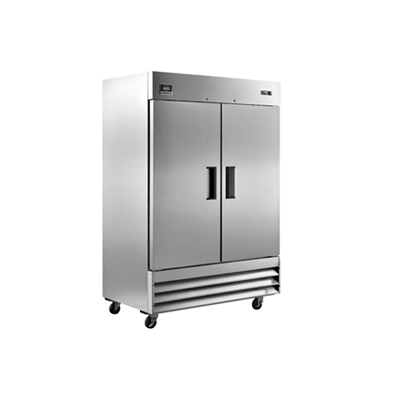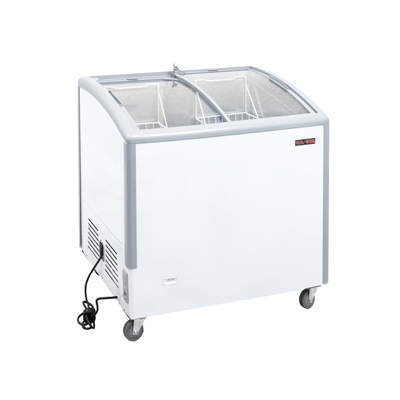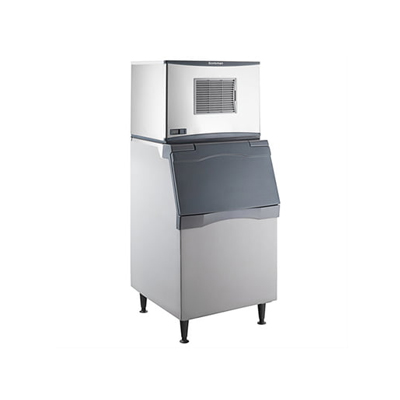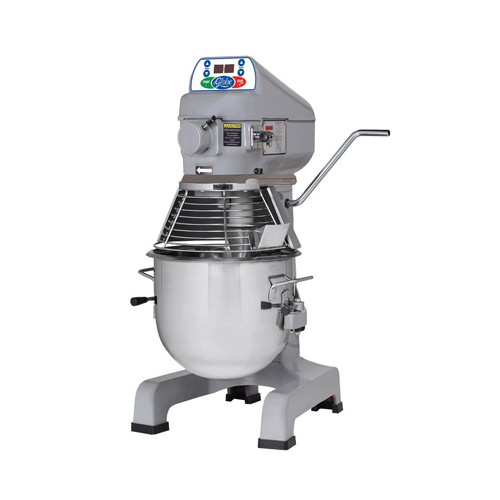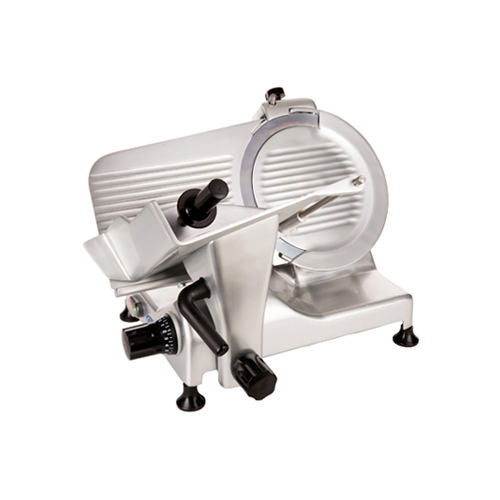Find the Best Ice Machines for Restaurants in Canada

Did you know that a single restaurant can use up to 1,000 pounds of ice weekly? For Canadian restaurants, having a reliable ice machine is crucial for maintaining operations and serving high-quality drinks. Whether you’re running a bustling bar or a fine dining establishment, the right ice machine can make all the difference.
In this guide, we’ll explore the top commercial and countertop ice machines designed for the restaurant industry. From compact undercounter units to large modular systems, we’ll cover options that fit every kitchen layout and production need. Our recommendations are backed by insights from trusted sources like The Home Depot and Food & Wine, ensuring you get both performance and reliability.
Efficient ice production is key to keeping your drinks refreshing and your operations smooth. With so many models available, choosing the right one can be overwhelming. That’s why we’ve put together this guide—to help you make an informed decision. Whether you’re looking for cube, nugget, or flake ice, we’ve got you covered.
For personalized advice, don’t hesitate to reach out to the experts at Babak Food Equipment. Call them today at 604-566-9747 for a consultation tailored to your restaurant’s needs.
Ready to find the perfect ice machine? Let’s dive in and explore the best options available to you.
Introduction to Ice Machines for Restaurants
Consistent and rapid ice production is the backbone of any successful restaurant. Whether you’re serving chilled beverages or preserving fresh ingredients, having a reliable ice maker is essential for maintaining smooth operations.
Why Ice Production Matters in Food Service
In high-demand environments, every second counts. Efficient ice makers can produce ice quickly, reducing downtime and ensuring your service remains swift. For instance, a restaurant serving 250 customers daily requires about 450 pounds of ice, making timely production crucial.
Traditional ice trays pale in comparison to modern ice machines. While trays are slow and labor-intensive, commercial ice makers offer consistent, high-volume production, eliminating the need for manual effort and freeing up staff for more critical tasks.
| Feature | Traditional Ice Trays | Modern Ice Makers |
|---|---|---|
| Production Speed | Slow, manual process | Fast, automated |
| Capacity | Limited (50-100 lbs/day) | High (300-1,000+ lbs/day) |
| Convenience | Low, requires frequent refills | High, continuous production |
| Cost | Low initial cost | Higher initial cost, lower long-term |
| Maintenance | Minimal | Regular maintenance needed |
Contact Babak Food Equipment at 604-566-9747 for Expert Advice
For tailored advice on selecting the right ice maker, contact Babak Food Equipment. Their experts can guide you in choosing a model that fits your restaurant’s specific needs, ensuring optimal performance and efficiency.
Modern ice-making technology not only enhances efficiency but also improves the quality of beverages served. By investing in a high-quality ice maker, restaurants can ensure consistent service and customer satisfaction, making it a vital component of daily operations.
Understanding Commercial and Countertop Ice Makers
Choosing the right ice maker for your restaurant involves understanding the differences between commercial and countertop models. Each type offers unique benefits tailored to specific needs.
Differences and Benefits for Restaurant Use
A commercial ice maker is designed for high-volume production, making it ideal for busy restaurants. These units can produce between 300 to over 1,000 pounds of ice daily, ensuring consistent supply during peak times. Their robust build and reliability make them a long-term investment.
In contrast, countertop ice makers are perfect for smaller spaces. They typically produce up to 400 pounds of ice daily, suiting bars or cafes with moderate demands. Their compact size and energy efficiency make them a practical choice without sacrificing performance.
Capacity is a crucial factor. Commercial models often have larger storage bins, holding up to 100 pounds, while countertop units store around 40 pounds. This difference impacts how much ice is available during busy periods.
Energy efficiency is another key consideration. Many commercial ice makers are Energy Star certified, reducing operational costs. Countertop models also offer energy-saving features, though their efficiency may vary based on usage.
Maintenance needs differ too. Commercial units require regular cleaning and filter changes to maintain performance, while countertop models are generally easier to maintain due to their smaller size.
When choosing, consider your restaurant’s size and demand. Assessing your peak ice needs helps select the right model, ensuring smooth operations and customer satisfaction.
Exploring Different Ice Machine Types and Designs
When it comes to ice, the shape and design play a significant role in both functionality and aesthetics. Whether you’re running a high-end bar or a bustling café, the right ice type can elevate your drink presentation and customer experience.
Cube, Bullet, and Nugget Ice Options
Cube ice is a classic choice, known for its slow-melting properties and classic appeal in cocktails. Bullet ice, with its compact cylindrical shape, excels in rapid cooling, making it ideal for fast-paced environments. Nugget ice, also known as chewable ice, is a favorite for its texture and ability to absorb flavors, commonly used in healthcare settings for patient comfort.
Each ice type offers unique benefits. Cube ice is perfect for preserving the flavor of premium spirits, while bullet ice quickly chills beverages without diluting them. Nugget ice, with its soft texture, is great for chewable convenience, especially in self-service areas.
Design innovations have made it possible to combine aesthetic appeal with efficient production. For instance, modular ice machines can scale with your needs, offering both high output and modern design. Undercounter models blend seamlessly into kitchen layouts, providing energy efficiency without compromising on performance.
When choosing an ice type, consider your menu and operational needs. High-volume restaurants might opt for cube ice for its durability, while cafes might prefer nugget ice for its chewable texture. Real feedback from popular models highlights these benefits, helping you make an informed decision.
Design aspects that balance efficiency with modern aesthetics ensure your ice machine fits seamlessly into your kitchen. Whether it’s a sleek undercounter unit or a modular system, the right design enhances both form and function, supporting your restaurant’s operations and style.
Production speeds and output consistency vary among designs. Cube ice machines may offer higher production rates, while nugget ice machines provide quicker access. Understanding these factors prepares you for further discussions on production metrics and selecting the best fit for your establishment.
For tailored advice on selecting the perfect ice machine, visit Babak Food Equipment. Their experts can guide you in choosing a model that fits your restaurant’s specific needs, ensuring optimal performance and efficiency.
Key Specifications and Production Metrics
When evaluating ice production systems, understanding key performance metrics is essential for making informed decisions. Two critical factors to consider are production capacity and storage capacity. These elements directly impact your ability to meet demand during peak times.
Ice Production Capacity and Rate
Production capacity is measured in pounds of ice produced over 24 hours. For example, a small café might require a unit producing around 100 pounds daily, while a mid-sized restaurant needs between 300-600 pounds. High-volume establishments may require over 1,000 pounds per day. It’s important to choose a model that aligns with your specific needs to ensure consistent service.
Production rate is how quickly ice is made. Modern units can produce ice in as little as 10 minutes, which is crucial during busy periods. Consider real-world examples: the Manitowoc ID-0422A produces 425 pounds daily, ideal for moderate use, while the Scotsman C1030 produces 1,000 pounds, suitable for large operations.
Storage Considerations for High-Volume Use
Storage capacity is equally important. A mid-sized restaurant typically needs a bin holding 100-300 pounds, while large operations may require over 500 pounds. Sufficient storage ensures you can handle peak demand without running out of ice.
| Model | Production Rate | Storage Capacity | Ideal Usage |
|---|---|---|---|
| Manitowoc ID-0422A | 425 lbs/day | 100 lbs | Moderate demand |
| Scotsman C1030 | 1,000 lbs/day | 500 lbs | High-volume |
| Hoshizaki KM-500 | 500 lbs/day | 300 lbs | Busy restaurants |
Understanding these metrics helps you select the right unit for your needs, ensuring efficient operation and customer satisfaction. Always assess your peak demand and choose a model with adequate capacity.

Energy Efficiency and Cost Savings Benefits
Energy efficiency is a cornerstone of modern restaurant operations, offering significant long-term cost savings. By choosing models with high energy ratings, you can reduce operational expenses while maintaining performance.
How Energy Ratings Impact Performance
Energy ratings play a crucial role in determining the efficiency of your equipment. A higher rating typically means lower energy consumption, which translates to cost savings over time. For instance, ENERGY STAR certified ice makers are designed to be more efficient, using less energy while producing the same amount of ice per day.
- Significance of Energy Ratings: They indicate how efficiently a unit uses resources, directly impacting your utility bills.
- Energy-Efficient Models: These reduce operational costs by consuming less energy without compromising production capacity.
- Daily Benefits: Lower energy use each day leads to noticeable savings over months and years.
- Technical Features: Look for self-cleaning mechanisms and advanced water filtration systems that enhance efficiency.
According to data, upgrading to an ENERGY STAR model can reduce energy use by up to 34%. This not only cuts utility costs but also contributes to environmental conservation by lowering your restaurant’s carbon footprint.
Regular maintenance, such as cleaning filters and ensuring proper water flow, helps sustain efficiency. These practices maintain performance while keeping energy use low, ensuring you save money without sacrificing output.
Investing in an energy-efficient model is a smart decision. It offers both financial benefits and environmental advantages, making it a wise choice for any restaurant aiming to reduce costs and enhance sustainability.
Design Considerations for Modern Restaurant Kitchens
Modern restaurant kitchens are spaces where functionality meets aesthetics. The design of your kitchen plays a crucial role in efficiency and workflow, especially when integrating essential equipment like ice makers.
When selecting an ice machine, it’s vital to consider the size of your kitchen. A unit that’s too large can overwhelm the space, while one that’s too small may not meet demand. Countertop ice machines are ideal for compact areas, offering practical solutions without sacrificing performance.
Design should complement your kitchen’s style and workflow. A well-chosen ice machine can enhance the overall look while maintaining efficiency. For instance, undercounter models blend seamlessly into the layout, providing a sleek appearance and saving valuable counter space.
| Design Consideration | Benefits |
|---|---|
| Compact Countertop Models | Space-saving, ideal for small kitchens |
| Undercounter Installation | Streamlined appearance, maintains counter space |
| Freestanding Units | Flexibility in placement, easy to install |
Strategic placement is key. Positioning your ice machine near where it’s most needed reduces movement and saves time. This not only enhances efficiency but also contributes to a smoother workflow.

Effective design improves both form and function. By thoughtfully integrating your ice machine, you create a kitchen that’s both visually appealing and operationally efficient.
Maintenance and Cleaning Tips for Long-Term Performance
Keeping your countertop ice maker in top shape ensures it runs efficiently and lasts longer. Regular maintenance isn’t just about fixing problems; it’s about preventing them. By following a few simple steps, you can keep your appliance performing like new.
DIY Cleaning Techniques
Start by turning off and unplugging your countertop ice maker to ensure safety. Wipe down the exterior with a mild detergent and warm water. For the interior, mix a solution of equal parts water and white vinegar to remove any buildup or odors.
- Descale Regularly: Use a descaling solution to remove mineral deposits that can affect performance. Follow the manufacturer’s instructions for best results.
- Check Water Filters: Replace filters every 6 months or as recommended to ensure clean water flow and ice production.
- Clean Condenser Coils: Dusty coils can reduce efficiency. Use a soft brush or vacuum to clean them monthly.
Expert tip from Babak Food Equipment: Schedule professional maintenance twice a year, especially in high-use environments. This ensures everything is in optimal working condition.
Avoid using harsh chemicals that could damage your countertop ice maker. Always follow the manufacturer’s guidelines to prevent voiding your warranty.
Regular maintenance can extend the life of your appliance and ensure it continues to produce high-quality ice. By following these simple steps, you’ll keep your countertop ice maker running smoothly for years to come.
Leveraging Technology for Optimal Ice Quality
Modern technology has revolutionized the way restaurants produce and maintain high-quality ice. Advanced features like water filtration systems and precise temperature control ensure clarity, consistency, and superior taste.
Water Filtration and Temperature Control
Advanced water filtration systems are crucial for enhancing ice quality. These systems remove impurities and minerals, resulting in clearer ice that tastes better. For instance, a nugget ice maker with a built-in filtration system can significantly improve the flavor profile of your beverages.
Temperature control plays a vital role in maintaining consistent ice quality. Modern units can regulate freezing temperatures precisely, ensuring that every batch of ice meets high standards. This level of control is especially beneficial for restaurants serving premium spirits, where ice quality directly impacts the drinking experience.
- Enhanced Clarity: Advanced filtration systems reduce impurities, resulting in crystal-clear ice.
- Consistent Taste: Pure water input ensures a neutral flavor, preserving the taste of drinks.
- Efficient Production: Precise temperature control speeds up the freezing process without compromising quality.
Innovative features like self-cleaning functions and smart sensors further enhance performance. These technologies not only maintain quality but also reduce maintenance downtime. For example, the Manitowoc Indigo NXT Series uses smart technology to optimize production, ensuring consistent results.

Investing in a nugget ice maker with these advanced features can elevate your restaurant’s ice quality, leading to greater customer satisfaction. By considering technological advancements, you can ensure your establishment serves the best possible drinks every time.
Installation and Space Optimization in Restaurant Settings
Proper installation is key to maximizing efficiency in your restaurant. Whether you’re setting up a countertop nugget ice unit or a larger system, careful planning ensures optimal performance and space utilization.
Start by measuring your available space accurately. This step is crucial to avoid installation issues. Consider the supply needs of your kitchen—ensuring your chosen model can produce enough ice per day to meet demand without overwhelming the space.
| Installation Type | Benefits | Ideal Usage |
|---|---|---|
| Countertop | Space-saving, easy access | Small kitchens, bars |
| Undercounter | Blends into layout, saves counter space | Busy restaurants |
| Freestanding | Flexibility, easy installation | Larger operations |
Positioning your unit near where it’s most needed enhances workflow. Regular maintenance, like cleaning condenser coils, ensures efficiency and prolongs lifespan. Planning for future space needs during installation helps avoid costly adjustments later.
Ice Machines: Features and Best Practices
Selecting the right features in an ice machine can significantly enhance your restaurant’s efficiency and customer satisfaction. Whether you’re upgrading or purchasing for the first time, understanding what makes a top-performing model stand out is crucial.
Effective Operation and Placement Strategies
When choosing an ice machine, consider features like auto shut-off, self-cleaning functions, and smart sensors. These not only simplify maintenance but also ensure consistent performance. For instance, models with advanced water filtration systems produce clearer ice, enhancing beverage quality.
Strategic placement is key to optimizing airflow and performance. Position your machine near where it’s most needed to streamline workflow. Regular maintenance, like cleaning condenser coils, is essential for efficiency and longevity.
| Feature | Benefit | Recommended Brands |
|---|---|---|
| Auto Shut-Off | Prevents overproduction, saving energy | Manitowoc, Scotsman |
| Self-Cleaning | Reduces maintenance time | Hoshizaki |
| Smart Sensors | Optimizes production based on demand | Scotsman |
Ensuring Smooth Integration into Your Kitchen
Proper integration enhances kitchen efficiency. Reputable brands offer reliable models with features that fit your specific needs. Training staff on equipment use ensures seamless operation and maintains customer satisfaction.

Enhancing Operational Efficiency with Quality Ice Production
High-quality ice production is the cornerstone of streamlined service in busy environments like bars. By ensuring consistent and rapid ice production, restaurants can reduce downtime and improve customer satisfaction.
In the fast-paced setting of a bar, the type of ice production system can make a significant difference. Modern units offer advanced features such as auto shut-off and smart sensors, optimizing production based on demand. For instance, models like the Manitowoc ID-0422A produce 425 pounds of ice daily, ideal for moderate bar use, while the Scotsman C1030 produces 1,000 pounds, suitable for high-volume bars.
A machine with a light footprint, both in energy consumption and space, is crucial for operational efficiency. Energy-efficient models not only lower operational costs but also promote sustainability. Additionally, compact designs, such as undercounter units, save valuable space without compromising performance.
| Model | Production Rate | Storage Capacity | Ideal Usage |
|---|---|---|---|
| Manitowoc ID-0422A | 425 lbs/day | 100 lbs | Moderate demand |
| Scotsman C1030 | 1,000 lbs/day | 500 lbs | High-volume bars |
| Hoshizaki KM-500 | 500 lbs/day | 300 lbs | Busy bars |
Reduced downtime from efficient ice production directly translates to improved customer service. By focusing on quality and technology, restaurants can achieve superior operational outcomes, ensuring every drink served meets high standards and enhances customer satisfaction.
Comparing Top Brands and Models in the Market
When it comes to selecting the perfect ice maker for your restaurant, understanding the differences between top brands and models is essential. Factors like production capacity, design, and user reviews play a crucial role in making an informed decision. In this section, we’ll compare leading brands and models, highlighting their unique features and performance metrics.
Insights from Leading Retail Sources
According to insights from reputable sources like The Home Depot and Food & Wine, several models stand out for their exceptional performance. The Manitowoc ID-0422A, for instance, produces 425 pounds of ice daily, making it ideal for moderate-demand restaurants. On the other hand, the Scotsman C1030 is a high-volume model, producing 1,000 pounds of ice daily, suitable for busy establishments.
- Popular Models: Manitowoc ID-0422A, Scotsman C1030, Hoshizaki KM-500.
- Key Features: Production capacity, ice quality, design, and energy efficiency.
- User Reviews: Customers praise the Manitowoc ID-0422A for its consistent performance and reliability.
When comparing specifications, production height and ice cube quality are critical. The Manitowoc ID-0422A excels in producing high-quality ice cubes, while the Scotsman C1030 is known for its rapid production and durability. Design differences also matter; for example, the Hoshizaki KM-500 offers a compact design perfect for smaller kitchens.

Warranty and service are additional factors to consider. The Manitowoc ID-0422A comes with a comprehensive warranty, ensuring long-term reliability. The Scotsman C1030, while more expensive, offers superior durability and energy efficiency, making it a worthwhile investment for high-volume restaurants.
In conclusion, each model has its strengths, whether it’s the Manitowoc ID-0422A’s balance of performance and cost or the Scotsman C1030’s high-volume capacity. By weighing these factors, you can choose the perfect ice maker for your restaurant’s needs. For personalized advice, contact Babak Food Equipment today.
Practical Tips for Integrating Ice Makers into Your Menu
Integrating an ice maker into your restaurant’s menu can elevate both service quality and customer experience. Start by positioning your product as a key element of your service model, ensuring it aligns with your menu’s style and presentation.
The right product can transform your beverage offerings, enhancing both presentation and appeal. For instance, Manitowoc’s high-quality ice cubes are perfect for craft cocktails, while Scotsman’s nugget ice adds a unique texture to signature drinks.
Consider creative ways to incorporate various ice types into your menu. For example, use gourmet ice for premium spirits or chewable nugget ice for blended beverages. This not only enhances flavor but also adds visual appeal.
Operational benefits abound with a dedicated product. Efficient ice production reduces delays, ensuring smooth service during peak times. Align your equipment choice with your menu design to create a cohesive customer experience.
Coordinate with your kitchen staff to optimize usage. Train your team to leverage the product’s features, such as advanced filtration systems, for consistent quality. Top restaurant chains often integrate their ice systems seamlessly into their workflow, setting a high standard for efficiency and presentation.
Investing in a high-quality product supports sustainable growth, reducing operational costs and environmental impact. By choosing energy-efficient models, you enhance your restaurant’s reputation and bottom line.
Understanding the Technical Aspects of Ice Production
Ice production is more than just freezing water; it involves precise engineering and advanced technology. Let’s explore the science behind creating consistent, high-quality ice and how modern systems maintain optimal performance.
The Science Behind Freezing and Cube Formation
The process begins with the refrigeration cycle. The compressor compresses the refrigerant, raising its temperature and pressure. This hot gas then flows through the condenser, where it cools down and turns into liquid. The expansion valve reduces the pressure, allowing the refrigerant to enter the evaporator, where it absorbs heat from the water, causing it to freeze into ice. This cycle ensures efficient ice production and is crucial for maintaining consistent output.
Modern systems use smart sensors to monitor temperature and humidity, adjusting the freezing process for perfect cube formation. This technology prevents over-freezing and ensures each cube is uniform in size and clarity. For instance, countertop nugget systems use advanced water filtration and temperature control to produce soft, chewable nugget ice, ideal for healthcare and hospitality settings.
Traditional ice production relied on manual processes, which were slow and inconsistent. Modern automated systems, however, offer rapid production with minimal oversight. This shift has significantly improved efficiency and output in commercial settings.
Maintaining performance during continuous use is achieved through robust components like heavy-duty compressors and evaporators. These components are designed to handle high demand without compromising quality. Regular maintenance, such as cleaning and filter changes, further ensures longevity and efficiency.
Understanding these technical aspects helps you make informed decisions when selecting an ice production system. By appreciating the engineering and technology involved, you can choose a system that meets your specific needs and ensures years of reliable service.
Navigating Purchase Decisions and Expert Recommendations
Choosing the right maker for your restaurant can feel overwhelming, but with a clear approach, you can make an informed decision. Start by evaluating your needs: consider your daily demand, available space, and menu requirements.
Begin with production capacity. If your restaurant serves 250 customers daily, aim for a model producing around 450 pounds of ice. Next, balance this with your kitchen space—compact countertop units are ideal for small areas, while larger operations may need modular systems.
Expert advice can simplify your decision. According to Babak Food Equipment, prioritize features like energy efficiency, durability, and maintenance support. ENERGY STAR certification, for instance, can reduce energy and water use by up to 16% and 20%, respectively.
Hands-on demonstrations and consultations are invaluable. They allow you to assess performance and fit firsthand. When comparing models, review multiple options and obtain quotes to ensure the best fit for your budget and needs.
Long-term savings come from informed decisions. Verify warranty terms and service support before purchasing. For personalized guidance, contact experts like those at Babak Food Equipment at 604-566-9747. Their expertise can help you navigate complex choices and find the perfect solution for your restaurant.
Conclusion
Choosing the right equipment for your restaurant is a decision that impacts both service quality and operational efficiency. Throughout this guide, we’ve explored the key differences between commercial and countertop systems, highlighting their unique benefits for different restaurant sizes and needs.
Production capacity, ice quality, and maintenance are critical factors to consider. Whether you’re serving a small café or a bustling bar, aligning your equipment choice with your menu and workflow ensures smooth operations. Remember, smart equipment decisions can enhance customer satisfaction and reduce long-term costs.
For personalized advice, reach out to the experts at Babak Food Equipment at 604-566-9747. Their team can guide you in selecting the perfect model for your needs, ensuring optimal performance and efficiency.
Thank you for reading! We hope this guide has equipped you with the insights needed to make an informed decision. For further assistance, don’t hesitate to contact the experts today.


